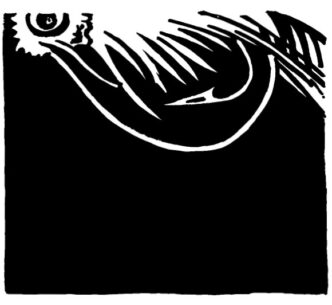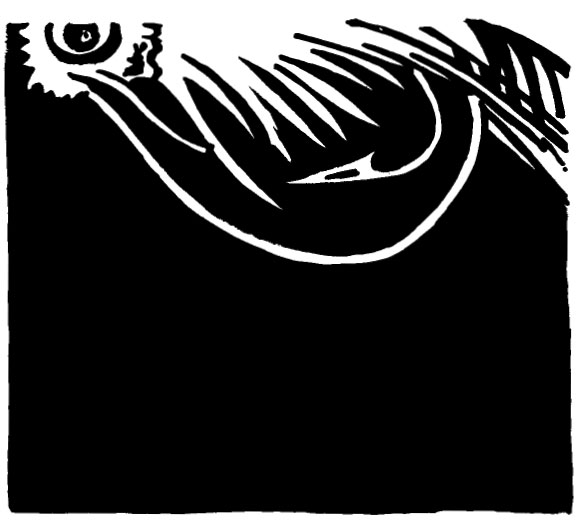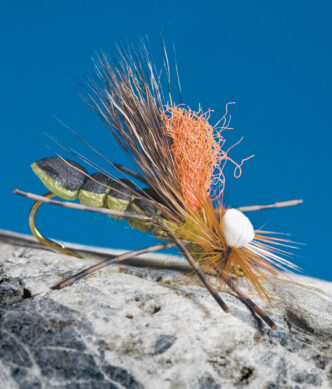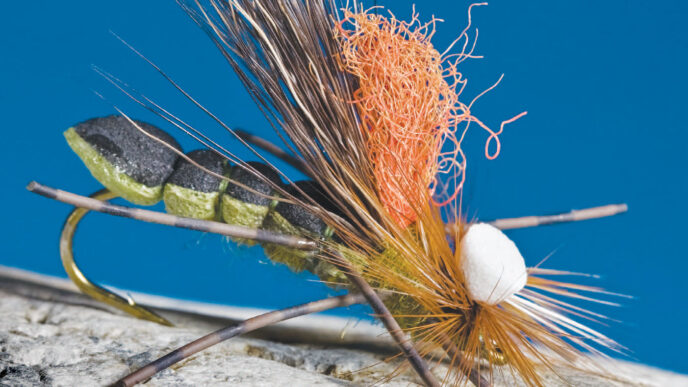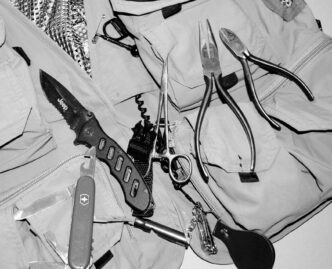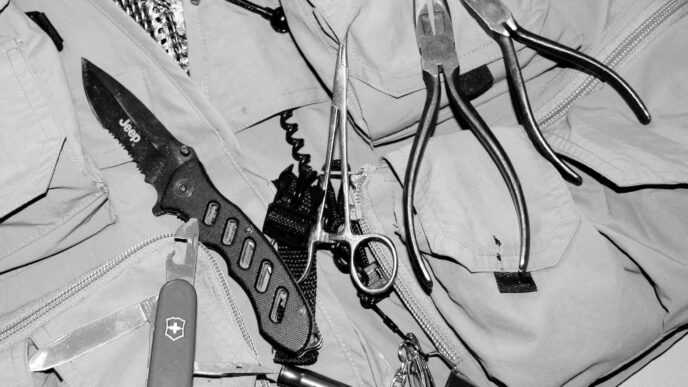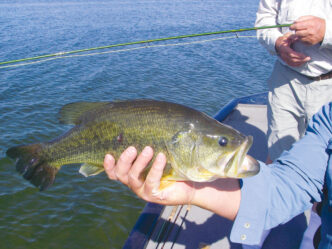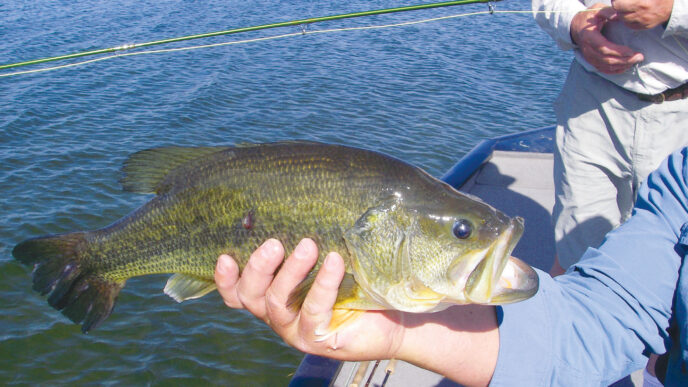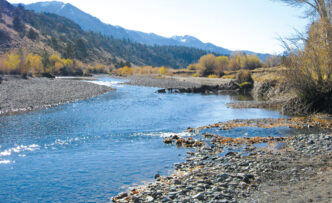To a gardener, the title of this column means “by-products of the worm’s digestive tract,” or, to put it succinctly, worm poop. To an angler, however, it should mean how to deliver and retrieve that worm imitation dangling from the tip of your rod.
Presentation, or how the fly gets where it’s going and how it comes back, is most of the art of fishing in still waters. Yes, you have to use a fly the fish thinks is something good to eat, but after the fly arrives in front of the fish, it must act as if it is alive, which is the second half of the presentation. When fishing a worm fly, there are a number of casts you can use to deliver the fly and retrieve in such a manner that it will attract bass, but first, let’s focus on the worm pattern itself.
The irony of worm flies is that they are an imitation of an imitation, designed intentionally to mimic the highly effective plastic worm favored by most conventional-tackle bass anglers. They are also relatively plentiful. Flies for Bass and Panfish, by Dick Stewart and Farrow Allen (Mountain Pond Publishing, 1992), presents a dozen patterns that either mimic the plastic worm or mimic something snakelike. Almost every fly angler who fishes for bass at all has fished some kind of worm, faked in feather, fur, or both.
Worm imitations are slender, slinky, and soft. When wet, a well-designed worm fly moves fluidly in the smallest of currents, creating the illusion of life that attracts bass. I’ve never felt that the original plastic worm necessarily makes the bass think it is eating a real worm. It’s just that the soft plastic feels like a living creature, and the visual stimulus of the gently waving worm tail likewise gives the illusion of life. Worm imitations created from feathers or fur do the same basic task of getting the bass to bite.
However, the other thing that earns the strike is the way the worm fly is presented. In stream situations, the trout angler most often wants the fly that he or she is presenting to drift as naturally as possible in the current. In lake or pond fishing for bass and panfish, though, the opposite is usually the case. The minor movements of the worm fly as it sinks and is retrieved need to be modified and amplified by the angler using stripping actions and rod-tip motions to make the worm come alive.
I can think of only two times when a bass hit a worm fly while it was sitting still on the bottom. One was when a gust of wind blew my hat off and I lay the rod down to reach for it. Just as I went to pick the rod up, it started heading for the water. The other time was when I stood gawking at a low-flying airliner, and a big bass nearly jerked the rod from my hands. Every other bass I’ve caught on a worm pattern came while I was moving the fly or during the short pauses between retrieves.
One very effective cast is what bass anglers call “flippin’” or “pitchin’.” This short-range cast results in the vertical entry and sinking of a worm fly that has been tied with a bit of weight at the nose. It is a cast to obvious targets, such as a dense line of tules or other vertical structure like dock pilings. At Martinez Lake, on the lower Colorado River, a house that has a cinder-block retaining wall is situated not far from the launch ramp at the Martinez marina. Water depth along this wall averages about four feet, and there’s usually a fair amount of trash, leaves, and floating brush pushed against it by the wakes generated from boats entering and leaving the marina.
Early one bright May morning, I was slipping along silently in my float tube, flipping a nose-weighted worm fly so that it hit the wall a few inches above the surface, then sank straight down through the floating debris. The line hadn’t reached the surface yet when the leader darted to one side. I set the hook and soon landed a handsome largemouth that weighed just over three pounds. I took a total of six bass off that wall that morning, the smallest a two-pounder that had a nasty cut, probably from a propeller, and the largest a hefty four pounds, seven ounces.
The flippin’ presentation isn’t really casting. It’s just swinging the fly on a length of line and leader that is approximately the length of the rod. The idea is to swing the fly gently into a small target area and have it arrive with almost no horizontal motion, so it slides into the water with a minimum of disturbance and falls as close to the vertical as you can make it by lowering the rod tip to follow the downward movement of the fly.
A long rod is best for this. I generally use at least a 9-foot rod to flip a worm, and a 10-foot or even 12-foot rod is even better. Because the entry angle is as nearly as vertical as you can make it, you can target small openings in matted reeds or floating brush or drop the worm fly straight down a wall, post, rock, or anything else that forms solid structure that attracts bass to lurk there.
If your worm reaches the bottom without being eaten, you can simply let it lie there for a few seconds, then twitch it gently a couple of times before slipping it up and out for another cast. I usually make no more than two casts to a particular opening or spot before moving on to the next likely spot. If there is a bass there to see the worm enter the water, and you don’t spook it, your first cast is the most lethal one.
This is a particularly good presentation for the float-tubing fly angler. You can move in close to your targets without spooking the fish, and when you get a strike, you are more likely to see it. Of course, the strike you want is the savage sideways lunge by a big bass that nearly rips the rod from your hands. On the other hand, if you put the worm fly into the water with zero disturbance, the strike is often a minor twitch in the leader that tells you a bass has drifted over and vacuumed up the fly by flaring its gills.
The worm imitation that is best for this kind of fishing has enough weight to penetrate surface junk such as reeds lying on the surface or floating leaves, but not so much weight that the fly plunges to the bottom. The fly should sink, but slowly, rather than rapidly. For many years, I used a few wraps of lead wire (still a good option) at the head of the fly. I often added large bead-chain eyes, and later used a variety of lead or tungsten eyes to sink this type of fly.
Probably the most elegant solution to weighting worm flies, though, is the cone head, since it replicates the shape and weight placement of the lead weight used on Texas-rigged plastic worms. You could, I suppose, use lead worm weights (pointed lead weights like coneheads), for all but the largest worm fly — even the lightest worm weight is heavier than a heavy cone head. Bead-chain eyes and light brass and tungsten eyes still work just fine in more open water and sink more slowly than a heavy, conehead-weighted fly.
A cone head on a worm fly likewise easily penetrates through leaves and trash floating on the surface. Lead eyes or beadchain eyes, conversely, tend to catch in this stuff, a nuisance I can live without. A worm fly with a cone head is a fly you can fish in all sorts of heavy cover and get the fly back. You should also tie or buy the pattern with a nylon-loop weed guard, because a properly fished worm fly is going to be in contact with the bottom, rotting tree limbs, rocks, and aquatic vegetation most of the time.
Flippin’ is not the only way to fish a worm fly. The worm fly can be cast fair distances and retrieved with a jigging action. I don’t know of any creature that hops and skips across the bottom like Little Red Riding Hood on her way to see Grandma, but with a worm fly, twitching or jigging the fly so it hops off the bottom a few inches, then settles nose first, gives that slender tail a chance to wave and wiggle. Bass are primarily visual predators and are quick to take notice of movement.
If you are fishing your worm on a floating line, the hopping motion has more of a vertical component than when you fish the same fly on a sink-tip or full sinking line. I generally fish a floating line with a worm fly when I can, because I like the up-and-down motion I can give the fly. I think this is more easily seen at longer distances than a darting-ahead action that just barely lifts the fly off the bottom.
The depth at which I can make this work is approximately equal to the length of the leader. With my 9-foot bass rod and a floating line with a leader the same length as the rod, I can create the hopping motion in water six to eight feet deep without dragging down the tip of the line. I don’t like to fish the tip submerged, because I watch it like a hawk — it’s my strike indicator.
You can cover a lot of water and catch a lot of bass and never have to present your worm fly deeper than that. From the surface to eight feet or so of water covers the primary nesting areas in the spring and nearly all of the shallow feeding zone where bass hunt food during the morning and evening. It’s also the area you can see the best with a decent pair of polarized glasses. If you are fishing from a boat or float tube, you may also have a depth finder to pick out bottom features that hold fish. If you are prospecting a bass pond on foot, you won’t have the benefits of such a device. Either way, the best bass-holding structure is probably at least partly visible.
There’s another productive presentation you can make using a sinking line and a worm fly that is either neutrally buoyant or that floats. Make a long cast over a submerged grass bed, and this time the fly will tend to ride up just above the weeds, making its slow progress highly visible to every bass in the area.
It’s kind of tricky to find the right combination of weight and floatation that gets the fly to rise off the bottom just a little, but not so much that it pulls the leader all the way back to the surface. You can use weight placed on the leader to hold the fly to the point above the bottom you require. A couple of years ago, while fishing a small pond in the San Gabriel mountains for trout, my wife and I discovered the lake also had bass in it. The bottom of this lake was layered with aquatic weeds that grew about a foot high in four feet of water. By placing a small worm weight anchored to the leader with a piece of toothpick jammed in the hole in the center of the little weight, I was able to fish a buoyant worm fly suspended about six inches or so above the weed tops. The bass were cruising just over the weeds, and I caught four or five in half an hour using this rig.
The same approach, by the way, works very well using a Dahlberg Diver or a Muddler Minnow. You’ll need more weight, but it allows you to dive the bug beneath the surface and then let it slowly rise toward the surface. It also works great with a frog pattern, with or without extra weight. The sinking line makes the frog dive on a strong strip of the line, then the frog slowly glides back to the surface.
Worm flies do not just imitate worms, either. I fish worm flies as crayfish imitations. There are plenty of good crayfish patterns to be found in fly shops, some so realistic they startle you. I sometimes ply them, but a soft, fluffy worm fly tied in crayfish colors often works just as well. I’ve had some good crayfish “worm” fishing using a fly tied entirely of rabbit fur. It is slinky when wet. I tie one in a rusty orange “body” and a dirty olive-green tail.
Just as warmwater fly fishers can learn from conventional-tackle bass anglers how to present flies that mimic plastic worms, we also can learn how best to fish worm flies as crayfish imitations. Crayfish crawl as their primary mode of movement. When not alarmed, they wander about in search of food by crawling slowly head first. Bass anglers with bait-casting or spinning gear imitate this with a retrieve they call “stitchin’.” The retrieve used by a good bass angler fishing a live crayfish is positively glacial. It can take him 20 minutes to fish out a long cast. What he is doing is trying to feel is every tiny motion of the live crayfish. It doesn’t like being dragged by a hook in its horny beak, and it grabs on to every stick and tries to crawl under every stone. When a bass approaches, the crayfish kicks rapidly as it attempts to flee, and that alerts the angler that the action is about to improve.
You can emulate this presentation by casting a full sinking line as far as you can into or across good bass habitat, then retrieving it as slowly as you can stand, either in short twitches or by using a finger-twist retrieve. If you don’t know how to do this retrieve, try YouTube and search for “crayfish,” “crawfish,” or “finger-twist retrieve” or “hand-twist retrieve.” It can be surprisingly effective. Since the full-sinking line keeps the fly in contact with the bottom throughout the retrieve, you get sensitive to the bottom and can feel the difference between a twig or a rock or soft weeds. You will usually detect a pickup by a bass pretty easily.
When threatened, the crayfish can also dart backward, using its tail as a “swim fin” to move rapidly. On a sinking line, you can imitate this behavior with a series of quick strips that make the fly dart ahead about six inches. You’ll want to perform this by striping line while the rod tip is pointed right at the fly. This spring, try one or all of these “worm casts,” and I think you’ll score more bass and have more fishing fun.



